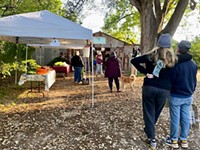SXSW Panels: The Future of Food and Drink
Highlights from the 2017 food track
By Emily Beyda, 6:15PM, Sun. Mar. 12, 2017
On Instagram, SXSW can look like an endless stream of celebrity sightings and themed cocktails. But in between the madness, culinary experts are quietly shaping the global conversation about food and drink. Here are a few highlights from some of the most thought-provoking panels.
Hunter, Gatherer, Chef: Going Beyond Farm to Table
Saturday, March 11, The DriskillWith farm-to-table cooking getting more and more popular in the United States, the panelists focused on issues of authenticity and how a preoccupation with personal expression through food has led to an increased public interest in hunting and gathering both in professional and home kitchens. As Susan Ebert from Field2Table put it, “Anything you forage is almost exquisitely ephemeral, it controls you. Like with pawpaws, or example, you have a window of eight to 10 days to find and preserve that fruit until it’s gone forever. I’m constantly watching because it changes the way you look at the landscape … you look at the entire natural world, then, as your grocery store.” Dai Due chef Jesse Griffiths talked about how difficult it used to be to cook locally, “It was pretty difficult in the beginning. It was hard to even find a chicken in Austin 10 years ago.” But now, farm-to-table eating is so popular that local eating is easier than ever. Still, Marla Camp, the editor of Edible Austin, cautions that, “As things grow and become popular, certain forces in the food industry come in and try to market things using a term rather than being the real thing,” and nose-to-tail pioneer Zakary Pelaccio disdainfully talked about restaurants that only locally source their greens, get everything else from Canada, then claim to be locally sourced. All the panelists felt that it’s our responsibility as consumers to keep in touch with our food, where it’s from and how it gets to us, buying from farmers' markets, locally foraging (Ebert says that fruit is a good place to start), and growing windowsill gardens even if we don’t have access to a backyard.
Beyond #FoodPorn, Changing the Media Diet
Saturday, March 11, the DriskillThis talk, put together by nonprofit newsroom the New Food Economy, focused on the ways in which food journalism is divided between two types of writing. On one side, there’s food porn that elevates the sensual aspects of consumption, on the other, industry focused coverage that commoditizes it. But the food system is undergoing a shift, so too should food media, and these writers are interested in bridging the gap between these two kinds of writing, doing work that is both consumer focused and centered on policy. Politico senior food and agriculture policy reporter Helena Bottemiller-Evich talked about a 3,000-word piece she wrote about the history of agricultural research; she thought no one would read it but it’s totally caught on, “Because we told the story in a way that connected people with the way they consumed packaged salads. It’s tricky to do, but you have to think about ways in which readers can relate to the policy issues that are going on in Washington and connect it to their own lives and experiences.” The future of food journalism is about illuminating policy issues through a personal lens. As Quartz staff writer Purdy put it, “Everybody eats, so everyone has a personal relationship to food that’s very universal and very political.” By writing and reading about food issues on a large scale, we have the power change consumption patterns on a personal level.
How the Slow Food Movement Is Changing Fast Food
Saturday, March 11, the DriskillBen Friedman and Brad Gillis opened Homegrown, their West Coast chain of sandwich restaurants, to address what they saw as systemic issues in the American food system. They discussed how food production is intimately linked to environmental and resource issues. In America, 70% of freshwater resources go into agriculture, and 70% of freshwater waste comes from agriculture. They wanted to create a larger impact by expanding public accessibility to slow food outside a fine dining environment, using the fast food mechanism to connect to the ideals of the Slow Food movement. As it stands now, 40% of Americans want to eat organic produce, but only 12% of produce is certified organic. During the growth of the fast food industries during the Eighties burger wars, the increasing popularity of fast food led to a growth in factory farming to keep up with burgeoning consumer demand. Fast food is typically highly processed and lacks nutritional density – having a longer shelf life at the expense of nutritional quality. It also has a negative impact on local food communities, animal welfare, increases health risks by lowering food quality, and has a huge environmental cost by relying on industrial agriculture. It used to be hard to opt out of fast food dining unless you were eating out at expensive restaurants, but within the last few years it has become easier and easier to access cheap, local options that align with your ideals. The Great Recession changed the market/demand for affordable, ethical food, as consumers had less money to spend on eating out, but still wanted to spend money in ways that they could feel good about. In response, there has been a new wave of restaurants that Friedman and Gillis call “slow food fast casual,” which combines slow food values with fast food accessibility. They believe that, “Slow food fast casual can change the industrial system that supports it,” by sourcing food ethically and lowering prices as their brand grows, having a big enough regional presence to keep food prices low, a business model that they believe will become more and more common as interest in sustainable eating grows across America.
Rebirth of Cocktail Culture in the U.S.
Saturday, March 11, Half Step Chris Bostick gathered a group of cocktail enthusiasts in a small tent behind his bar, Half Step, pouring out palomas and talking about the ways in which the American cocktail scene has changed since he started his bartending career in New York at an Asian fusion restaurant. “Nineties cocktails involved saketinis, we weren't mixing up old fashioneds or emphasizing liquor quality, but we were still focusing on hospitality.” He discovered the classic cocktail bar ethos at Sasha Petraske’s Milk & Honey, which Chris calls, “A new style of proto speakeasy,” and credits with bringing back vibrancy to American cocktail culture. He took his new appreciation for craft cocktails back to his hometown in Austin, then to the Beverly Hilton, where he poured drinks for celebrity clients including George Hamilton (“Yes folks,” Chris reassured us, “he really is that color”), whose standing order was “A shot of Jack Daniels, an Arnold Palmer, and a Crab Louie salad.” But his career was interrupted when a broken collarbone trapped him in bed for six months. He started his own cocktail blog so he could keep in touch with the culture, and became aware of the ways in which cocktails were gaining popularity, saying, “You used to only have bars on the coasts. Now the community is robust, there's cocktail bars in Des Moines, Iowa.” Once recovered, Bostick partnered up with friends from the L.A. cocktail scene to open Half Step in his hometown, a process that was considerably more involved than he expected. It took Chris and his partners four years to find and revamp the property and get all the necessary permits. They had to do a major renovation on the space they rented, which was super run-down. They essentially had to tear down the whole house and rebuild, preserving the facade according to the historical code, and reusing much of the original lumber to give their space a vintage feel. Now, Half Step is a cocktail bar that Bostick believes expresses many of the best qualities of American cocktail culture, with bartenders who are thoughtful, expertly trained, but ultimately interested in creating an unpretentious atmosphere. “We don't want to sell you cocktails, we want to sell you a good time & earn your trust …. In the words of Sasha Petrowski: Everybody is invited once. Whether you come back after that or not is up to you.”Urbanization of Beer, Wine, and Spirits
Saturday, March 11, the DriskillIn a panel hosted by Tipsy Texan and Patron Spirits trade education and mixology manager David Alan, Greenbar Distillery co-founder Melkon Khosrovian, Infinite Monkey Theorem urban wineries co-founder Ben Parson, and Blue Owl Brewery co-owner Suzy Shaffer discussed the future of craft beer, wine, and spirits in urban spaces across America. Traditionally, cocktail creation was centered around where agriculture was, on farms, in rural areas, where they would grow, but Prohibition shut down the formal distillation industry, and put a real cramp on the informal distillation industry. In colonial times there were hundreds of distilleries, but by the Eighties, when independent distillation started to slowly make a comeback in America, just a handful remained. In 1995, when Tito’s Vodka came to Austin, there were zero Texas distilleries. When Tito’s applied for a permit to start the first Texan distillery, the paperwork didn’t even exist; they had to work with the government to introduce a new process. The growth process has been speeding up in recent years. In 2003, there were between 30 and 60 distillers in America, as of last year 1,315 distilleries. The same is true for beer and wine, now that we have a nationalized transportation system and refrigeration, there is no need for distillation and fermentation to be based around agricultural production of their raw materials. Instead, brewers, vintners, and distillers are heading into the cities where their customers live.
All three panelists insisted, though, that just because their companies aren’t agrarian doesn’t mean they’ve lost the value they place on terroir, which all three described as the center of their business. As Khosrovian put it, we should think of urban terroir in terms of the people, tools, and technology rather than dirt and atmosphere. For Shaffer, terroir comes both from the atmosphere of the brewery itself and a close connection with their neighbors and community, including sponsoring local fundraisers, and regularly hosting open community nights to let people in the neighborhood have input on what flavors they’ll use in their new beers. She believes in keeping things fun, saying “It’s important for us to listen to something fun, like Jackson 5, while we’re brewing, and make sure that it’s really seeped into the brewing.” As an urban brewer, she can focus on making high-quality craft liquors accessible to consumers, making, “an approachable, affordable sour for people who are active explorers, who want to take it with them,” canning her beers to make them eco-friendly, and compatible with the active Austin lifestyle. But it hasn’t always been easy. “We had a fairly rocky start, we overlapped three different neighborhood associations so we had to sit down and talk with a lot of people, make connections so we could understand each other. We heard all of our neighbors’ concerns, and built our business around that, to make a space that the neighborhood would want. It’s important to us to help the neighborhood grow, and be a part of it.” Still, while urban brewing has its challenges, she very much feels that it is worth the extra work and expense to be close to the people who love drinking her beer as much as she loves brewing it. As Parsons put it, “Why do we choose to live in cities? We live in cities because we love the art, the expression, the cultural identity, and I think that wine inherently takes on a sense of that place.”
A note to readers: Bold and uncensored, The Austin Chronicle has been Austin’s independent news source for over 40 years, expressing the community’s political and environmental concerns and supporting its active cultural scene. Now more than ever, we need your support to continue supplying Austin with independent, free press. If real news is important to you, please consider making a donation of $5, $10 or whatever you can afford, to help keep our journalism on stands.
Richard Whittaker, March 17, 2017
Wayne Alan Brenner, March 13, 2017
April 17, 2020
March 16, 2020
SXSW 2017, Suzy Shaffer, SXSW Interactive 2017, David Alan, Melkon Khosrovian, Ben Parsons, Jesse Griffiths, Marla Camp, Susan Ebert, Zakary Pelaccio, Corby Kummer, Kate Cox, Chase Purdy, Helena Bottemiller-Evich, Ben Friedman, Brad Gillis, Chris Bostick










